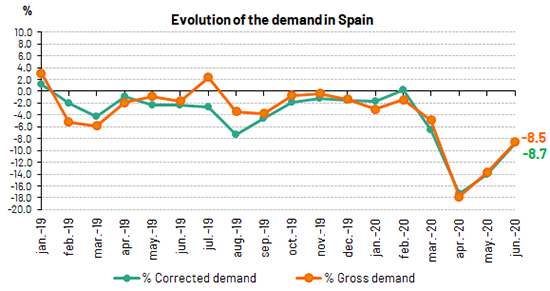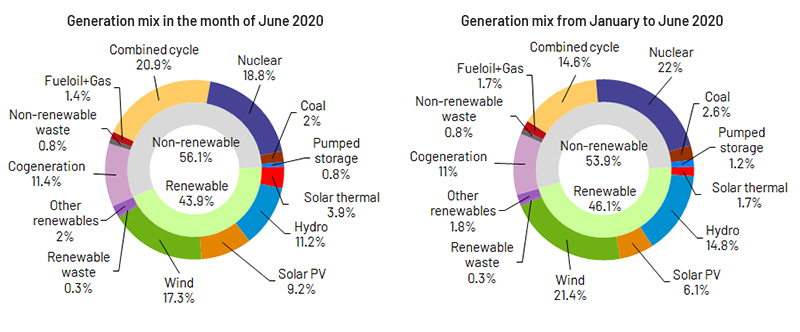For 40 years, we've been driving our country's economic and social progress. Four decades shaping Spain.
Demand for electricity in Spain falls 8.5% in June
- 43.9% of monthly generation came from renewable sources and 63.5% was produced from technologies that do not emit CO2 equivalent emissions.
- Demand for electricity in the Balearic Islands fell by 33.3% and in the Canary Islands by 14.4% compared to the same month in 2019.
- Solar photovoltaic, which produced 92% more than in June 2019, registered an all-time high for monthly generation at national level, reaching 1,792 GWh.
Red Eléctrica de España publishes the electricity demand for June, a month in which the country was still under the state of emergency for 21 days due to the Covid-19. In this context, the national electricity demand for June is estimated at 19,442 GWh, 8.5% less than that registered in the same month of the previous year. After having factored in the influence of seasonal and working patterns, this figure rises slightly to 8.7%.
The decline in June, less marked than that of April and May compared to the same months in 2019, shows a slight recovery in terms of energy consumption. During the period of the state of emergency (from 15 March to 21 June), demand was 13.3% lower in the Spanish electricity system compared to the same period in 2019.

In the first half of 2020, demand is estimated at 120,340 GWh, 8% less than in 2019. Again, after having factored in the influence of seasonal and working patterns, demand is 8% lower than in the same period last year.
In June, according to data estimated at the time of this press release, generation coming from renewable energy sources represented 43.9% of the total production. Therefore, during the first half of the year, overall renewable generation reached 46.1% of the total electricity generated nationwide.
63.5% of electricity generation during the month was obtained using technologies which produce zero CO2 equivalent emissions.
With information available as at the time of this press release, wind energy generation in June reached 3,366 GWh, a value 2.4% more than in the same period last year, and this accounted for 17.3% of the total generation nationwide.
For its part, solar photovoltaic energy registered in June an all-time high for monthly generation, producing 1,792 GWh, which represents a 92% increase compared to June 2019. Its contribution to the generation mix, 9.2% of the total, also represents a record share.

Demand for electrical energy in the peninsular electricity system falls 7.7%
Demand for electrical energy in the peninsular electricity system in the month of June is estimated at 18,437 GWh, 7.7% lower than that recorded in the same month last year. After having factored in the influence of seasonal and working patterns, the demand for electricity dropped 7.9% compared to June 2019.
In the first half of 2020, the demand for electricity on the Spanish peninsula is estimated at 113,989 GWh, 7.7% less than in 2019. Once again, after having factored in the influence of seasonal and working patterns, demand is 7.7% lower than that registered in the same period last year.
During the month, according to data estimated at the time of this press release, 45.2% of the peninsular generation came from renewable energy sources and 65.7% was obtained using technologies which produce zero CO2 equivalent emissions. For its part, wind energy stood at 3,259 GWh, a figure that is 1.4% higher than that registered in June last year and contributed 17.6% to the generation mix.
Demand for electricity in June decreased 33.3% in the Balearic Islands and 14.4% in the Canary Islands
In the Balearic Islands, the demand for electricity in June is estimated at 360,001 MWh, a value that is 33.3% lower than that registered in the same month last year. After having factored in the influence of seasonal and working patterns, the figure decreased by 32.7% with respect to June 2019. In the first half of 2020, overall demand in the Balearic Islands is estimated at 2,272,035 MWh, 18.7% less than in 2019.
Combined cycle, with 72.3% of the total, was the leading source of electricity generation in the Balearic Islands, where renewable technologies and those which produce cero CO2 equivalent emissions, accounted for 10.2%. For the sixth consecutive month, coal-fired generation was not used to produce a single MWh in the Balearic electricity system.
In regard to the Canary Islands, electricity demand is estimated at 611,688 MWh, 14.4% down on that registered in June 2019. After having factored in the influence of seasonal and working patterns, the figure drops by 14.9% with respect to the same month last year. So far in 2020, overall demand in the Canary Islands is estimated at 3,884,860 MWh, a decrease of 9.9% on the same period last year.
During June and according to current estimated data, combined cycle was the leading technology in the Canary Islands generation mix, with a contribution of 43.6%. Renewables and zero-emission technologies accounted for 21.3% of the generation on the Canary Islands.
Consult our Daily Balance Report for more information on the National, Peninsular, Balearic Islands and Canary Islands electricity systems as at the close of June.












